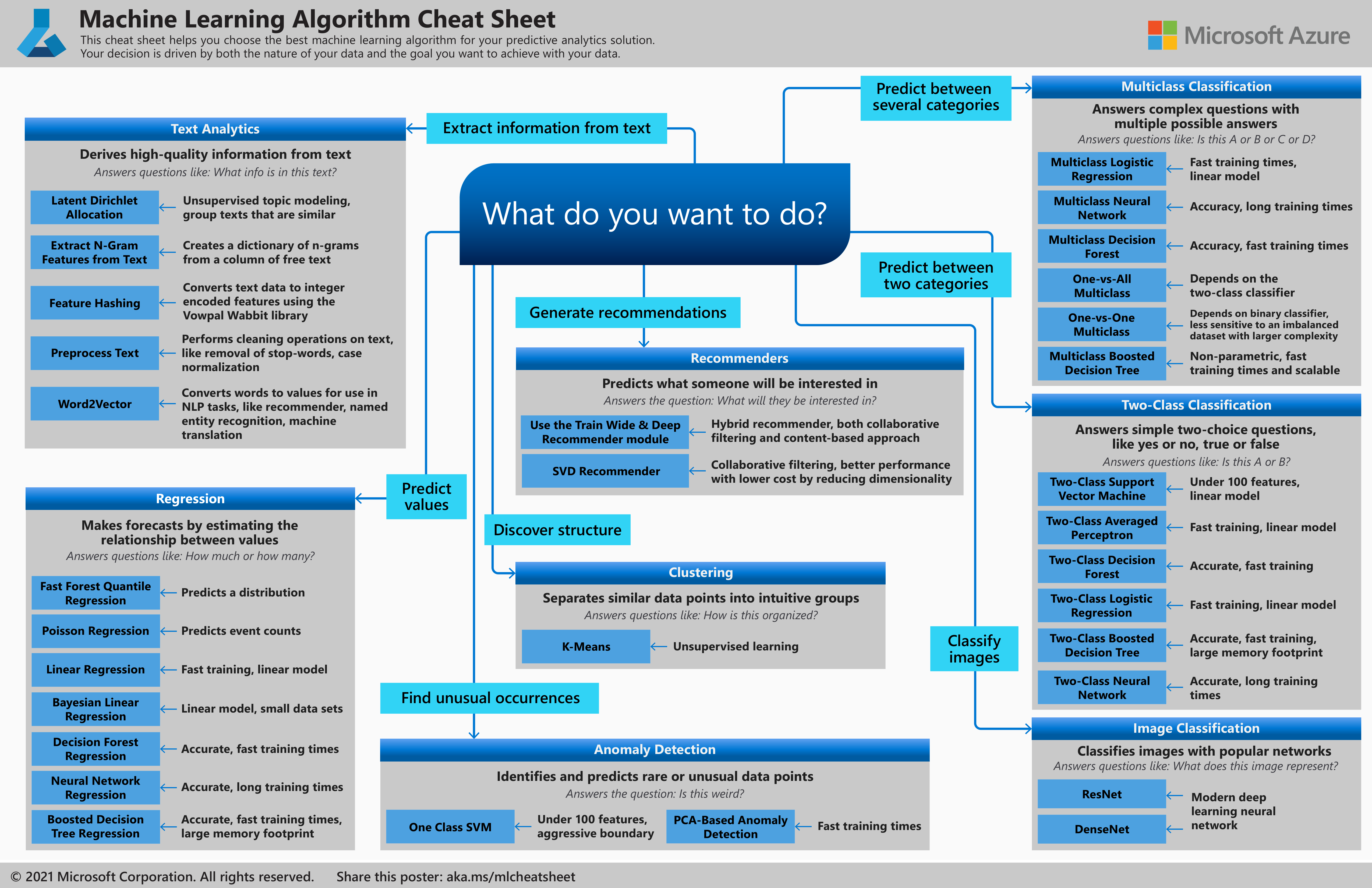Not
Åtkomst till den här sidan kräver auktorisering. Du kan prova att logga in eller ändra kataloger.
Åtkomst till den här sidan kräver auktorisering. Du kan prova att ändra kataloger.
Viktigt!
Den här artikeln innehåller information om hur du använder Azure Machine Learning SDK v1. SDK v1 är inaktuell från och med den 31 mars 2025. Stödet för det upphör den 30 juni 2026. Du kan installera och använda SDK v1 fram till det datumet. Dina befintliga arbetsflöden med SDK v1 fortsätter att fungera efter supportdatumet. De kan dock utsättas för säkerhetsrisker eller förändringar som bryter kompatibiliteten vid arkitektoniska förändringar i produkten.
Vi rekommenderar att du övergår till SDK v2 före den 30 juni 2026. Mer information om SDK v2 finns i Vad är Azure Machine Learning CLI och Python SDK v2? och SDK v2-referensen.
Fuskbladet för Azure Machine Learning-algoritmen hjälper dig att välja rätt algoritm från designern för en förutsägelseanalysmodell.
Kommentar
Designer stöder två typer av komponenter, klassiska fördefinierade komponenter (v1) och anpassade komponenter (v2). Dessa två typer av komponenter är INTE kompatibla.
Klassiska fördefinierade komponenter ger fördefinierade komponenter huvudsakligen för databearbetning och traditionella maskininlärningsuppgifter som regression och klassificering. Den här typen av komponent stöds fortfarande, men inga nya komponenter läggs till.
Med anpassade komponenter kan du omsluta din egen kod som en komponent. Den stöder delning av komponenter mellan arbetsytor och sömlös redigering i Studio-, CLI v2- och SDK v2-gränssnitt.
För nya projekt rekommenderar vi starkt att du använder anpassad komponent, som är kompatibel med AzureML V2 och fortsätter att ta emot nya uppdateringar.
Den här artikeln gäller för klassiska fördefinierade komponenter och är inte kompatibel med CLI v2 och SDK v2.
Azure Machine Learning har ett stort bibliotek med algoritmer från familjer för klassificering, rekommenderade system, klustring, avvikelseidentifiering, regression och textanalys. Var och en är utformad för att hantera olika typer av maskininlärningsproblem.
Mer information finns i Så här väljer du algoritmer.
Ladda ned: Fuskblad för Maskininlärningsalgoritm
Ladda ned fuskarket här: Machine Learning Algorithm Cheat Sheet (11x17 in.)
Ladda ned och skriv ut maskininlärningsalgoritmens fuskblad i tabloidstorlek för att hålla det praktiskt och få hjälp med att välja en algoritm.
Så här använder du maskininlärningsalgoritmens fuskblad
De förslag som erbjuds i den här algoritmens fuskblad är ungefärliga tumregler. Vissa kan böjas, och vissa kan kränkas på ett flagrant sätt. Det här fuskbladet är avsett att föreslå en startpunkt. Var inte rädd för att köra en head-to-head-tävling mellan flera algoritmer på dina data. Det finns helt enkelt inget substitut för att förstå principerna för varje algoritm och det system som genererade dina data.
Varje maskininlärningsalgoritm har sin egen stil eller induktiv bias. För ett specifikt problem kan flera algoritmer vara lämpliga, och en algoritm kan passa bättre än andra. Men det är inte alltid möjligt att veta i förväg, vilket är den bästa passformen. I sådana fall visas flera algoritmer tillsammans i fuskbladet. En lämplig strategi skulle vara att prova en algoritm, och om resultaten ännu inte är tillfredsställande kan du prova de andra.
Om du vill veta mer om algoritmerna i Azure Machine Learning-designern går du till referensen Algoritm och komponent.
Typer av maskininlärning
Det finns tre huvudkategorier för maskininlärning: övervakad inlärning, oövervakad inlärning och förstärkningsinlärning.
Övervakat lärande
I övervakad inlärning är varje datapunkt märkt eller associerad med en kategori eller ett värde av intresse. Ett exempel på en kategorisk etikett är att tilldela en bild som antingen en "katt" eller en "hund". Ett exempel på en värdeetikett är försäljningspriset som är associerat med en begagnad bil. Målet med övervakad inlärning är att studera många märkta exempel som dessa och sedan kunna göra förutsägelser om framtida datapunkter. Du kan till exempel identifiera nya foton med rätt djur eller tilldela korrekta försäljningspriser till andra begagnade bilar. Detta är en populär och användbar typ av maskininlärning.
Oövervakat lärande
I oövervakad inlärning har datapunkter inga etiketter associerade med dem. I stället är målet med en oövervakad inlärningsalgoritm att organisera data på något sätt eller att beskriva dess struktur. Oövervakad inlärning grupperar data i kluster, som K-means gör, eller hittar olika sätt att titta på komplexa data så att de blir enklare.
Kunskapsförmedling
I förstärkningsinlärning får algoritmen välja en åtgärd som svar på varje datapunkt. Det är en vanlig metod inom robotteknik, där uppsättningen sensoravläsningar vid en tidpunkt är en datapunkt, och algoritmen måste välja robotens nästa åtgärd. Det passar också naturligt för Sakernas Internet-program. Inlärningsalgoritmen får också en belöningssignal en kort stund senare, vilket anger hur bra beslutet var. Baserat på den här signalen ändrar algoritmen sin strategi för att uppnå den högsta belöningen.
